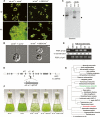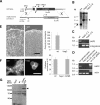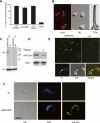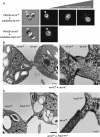The conserved plant sterility gene HAP2 functions after attachment of fusogenic membranes in Chlamydomonas and Plasmodium gametes
- PMID: 18367645
- PMCID: PMC2335326
- DOI: 10.1101/gad.1656508
The conserved plant sterility gene HAP2 functions after attachment of fusogenic membranes in Chlamydomonas and Plasmodium gametes
Abstract
The cellular and molecular mechanisms that underlie species-specific membrane fusion between male and female gametes remain largely unknown. Here, by use of gene discovery methods in the green alga Chlamydomonas, gene disruption in the rodent malaria parasite Plasmodium berghei, and distinctive features of fertilization in both organisms, we report discovery of a mechanism that accounts for a conserved protein required for gamete fusion. A screen for fusion mutants in Chlamydomonas identified a homolog of HAP2, an Arabidopsis sterility gene. Moreover, HAP2 disruption in Plasmodium blocked fertilization and thereby mosquito transmission of malaria. HAP2 localizes at the fusion site of Chlamydomonas minus gametes, yet Chlamydomonas minus and Plasmodium hap2 male gametes retain the ability, using other, species-limited proteins, to form tight prefusion membrane attachments with their respective gamete partners. Membrane dye experiments show that HAP2 is essential for membrane merger. Thus, in two distantly related eukaryotes, species-limited proteins govern access to a conserved protein essential for membrane fusion.
Figures






Similar articles
-
Membrane fusion triggers rapid degradation of two gamete-specific, fusion-essential proteins in a membrane block to polygamy in Chlamydomonas.Development. 2010 May;137(9):1473-81. doi: 10.1242/dev.044743. Epub 2010 Mar 24. Development. 2010. PMID: 20335357 Free PMC article.
-
Plasmodium berghei HAP2 induces strong malaria transmission-blocking immunity in vivo and in vitro.Vaccine. 2009 Aug 20;27(38):5187-94. doi: 10.1016/j.vaccine.2009.06.069. Epub 2009 Jul 9. Vaccine. 2009. PMID: 19596419 Review.
-
Species-specific gamete recognition initiates fusion-driving trimer formation by conserved fusogen HAP2.Nat Commun. 2021 Jul 19;12(1):4380. doi: 10.1038/s41467-021-24613-8. Nat Commun. 2021. PMID: 34282138 Free PMC article.
-
Is HAP2-GCS1 an ancestral gamete fusogen?Trends Cell Biol. 2010 Mar;20(3):134-41. doi: 10.1016/j.tcb.2009.12.007. Epub 2010 Jan 18. Trends Cell Biol. 2010. PMID: 20080406
-
Uncovering an ancestral green ménage à trois: Contributions of Chlamydomonas to the discovery of a broadly conserved triad of plant fertilization proteins.Curr Opin Plant Biol. 2022 Oct;69:102275. doi: 10.1016/j.pbi.2022.102275. Epub 2022 Aug 22. Curr Opin Plant Biol. 2022. PMID: 36007296 Free PMC article. Review.
Cited by
-
The cytoplasmic domain of the gamete membrane fusion protein HAP2 targets the protein to the fusion site in Chlamydomonas and regulates the fusion reaction.Development. 2015 Mar 1;142(5):962-71. doi: 10.1242/dev.118844. Epub 2015 Feb 5. Development. 2015. PMID: 25655701 Free PMC article.
-
Experimental Hybridization in Leishmania: Tools for the Study of Genetic Exchange.Pathogens. 2022 May 14;11(5):580. doi: 10.3390/pathogens11050580. Pathogens. 2022. PMID: 35631101 Free PMC article. Review.
-
Identification of Novel Malaria Transmission-Blocking Vaccine Candidates.Front Cell Infect Microbiol. 2021 Nov 30;11:805482. doi: 10.3389/fcimb.2021.805482. eCollection 2021. Front Cell Infect Microbiol. 2021. PMID: 34917521 Free PMC article. Review.
-
The EFF-1A Cytoplasmic Domain Influences Hypodermal Cell Fusions in C. elegans But Is Not Dependent on 14-3-3 Proteins.PLoS One. 2016 Jan 22;11(1):e0146874. doi: 10.1371/journal.pone.0146874. eCollection 2016. PLoS One. 2016. PMID: 26800457 Free PMC article.
-
Hap2, a novel gene in Babesia bigemina is expressed in tick stages, and specific antibodies block zygote formation.Parasit Vectors. 2017 Nov 13;10(1):568. doi: 10.1186/s13071-017-2510-0. Parasit Vectors. 2017. PMID: 29132437 Free PMC article.
References
-
- Adachi J., Hasegawa M. MOLPHY version 2.3: Programs for molecular phylogenetics based on maximum likelihood. Comput. Sci. Monogr. 1996;28:72–76.
-
- Billker O., Lindo V., Panico M., Etienne A.E., Paxton T., Dell A., Rogers M., Sinden R.E., Morris H.R. Identification of xanthurenic acid as the putative inducer of malaria development in the mosquito. Nature. 1998;392:289–292. - PubMed
Publication types
MeSH terms
Substances
Grants and funding
LinkOut - more resources
Full Text Sources
Other Literature Sources
